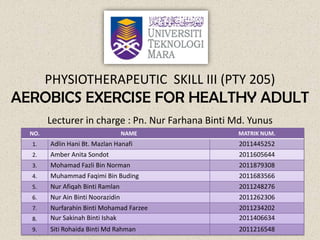
Aerobics exercise for healthy adult
- 1. PHYSIOTHERAPEUTIC SKILL III (PTY 205) AEROBICS EXERCISE FOR HEALTHY ADULT Lecturer in charge : Pn. Nur Farhana Binti Md. Yunus NO. NAME MATRIK NUM. 1. Adlin Hani Bt. Mazlan Hanafi 2011445252 2. Amber Anita Sondot 2011605644 3. Mohamad Fazli Bin Norman 2011879308 4. Muhammad Faqimi Bin Buding 2011683566 5. Nur Afiqah Binti Ramlan 2011248276 6. Nur Ain Binti Noorazidin 2011262306 7. Nurfarahin Binti Mohamad Farzee 2011234202 8. Nur Sakinah Binti Ishak 2011406634 9. Siti Rohaida Binti Md Rahman 2011216548
- 2. INTRODUCTION • Aerobics is a form of physical exercise that combines rhythmic aerobic exercise with stretching and strength training routine with a goal to improve all elements of fitness.
- 3. • It can be done at least 3 times a week and every sessions take about 20-30 minutes. • Aerobic can helps our body and minds relax. • It is usually performed to music and may be practiced in a group setting led by an instructor.
- 4. CONCEPT 1) FITNESS • The ability to perform physical work. • Fitness levels can be described on a continuum from poor to superior based on energy expenditure. 2) MAXIMUM OXYGEN CONSUMPTION • VO2max is measure of the body’s capacity to use oxygen. • It is the maximum amount of oxygen consumed per minute when the individual has reached maximum effort. • Expressed relative to body weight, as milliliter of oxygen per kilogram of body weight per minute (mL/kg per minute). • Endurance (a measure of fitness). • It is the ability to work for prolonged period of time and to resist fatigue.
- 5. • It includes – Muscular endurance Cardiovascular endurance 3) AEROBIC EXERCISE TRAINING (CONDITIONING) • Aerobic exercise training is augmentation of the energy utilization of muscle. • The improvement of the muscle’s ability to use energy is a result of ↑ levels of oxidative enzymes in the muscle, ↑ mitochondrial density and size and the ↑ muscle fiber capillary supply. 4) ADAPTATION • Adaptation results in increased efficiency of the cardiovascular system and the active muscle. • The higher the initial level of fitness, the greater the intensity of exercise needed to elicit a significant change.
- 6. 5) MYOCARDIAL OXYGEN CONSUMPTION • mVO2 is measure of the oxygen consumed by the myocardial muscle. • In a healthy individual, a balance between myocardial oxygen supply and demand is maintained during maximum exercise. 6) DECONDITIONING • Deconditioning occurs with prolonged bed rest patient. Resulting to reduce: -muscle mass -heart volume -strength -orthostatic volume -cardiovascular function -exercise tolerance -total blood volume -bone mineral density -plasma volume
- 7. PRINCIPLES INTENSITY How hard your body is working -moderate intensity aerobic -vigorous intensity aerobic DURATION How long the performance is -20-30 minutes is optimal -the greater intensity of the exercise, the shorter the duration needed to adapt
- 8. FREQUENCY How often the exercise should be -3-4 times a week depends on goals MODES Selecting types for aerobic exercise -depends on goal, physical condition, injury history e.g : high load, few repetitions = muscle strength light load, many repetitions = muscle endurance
- 9. PHYSIOLOGICAL RESPONSE 1) Cardiovascular response • Cardiac effects Frequency of sinoartrial node depolarization increase as does the heart rate. The decrease in vagal stimuli with an increase in SNS stimulation. • Peripheral effects Net reduction in total peripheral resistance. Increase cardiac output because of increase in - myocardial contractility. - heart rate. - blood flow through working muscle. Increase in systolic blood pressure - result from augmented cardiac output.
- 10. 2) Respiratory Response to Exercise • Respiratory changes occur rapidly. Which increase the : - gas exchange - body temperature - epinephrine - stimulation of receptors of the joint and muscles • Minute ventilation increase • Alveolar ventilation increase
- 11. 3) Responses Providing Additional Oxygen to Muscle • Increase blood flow • Increase oxygen extraction i. The more oxygen used by the working muscle decrease of the partial pressure of oxygen the unloading of oxygen from hemoglobin is facilitated. ii. Increase production of CO2 the tissue become more acidotic (increase concentration of H+ increase amount of O2 release from HB at any given partial pressure. iii. Increase RBC which 2,3-diphosphoglycerate (DPG) produce by glycolysis increase release of O2.
- 12. • Oxygen consumption Factor: • Vascularity of the muscle • Fiber disribution • Number of mithocondria • Oxidative mitochondrial enzymes present in the fibres
- 13. THE EXERCISE PROGRAM 1)THE WARM UP PERIOD • To enhance the numerous adjustments that must take place before physical activity. • Prevents the musculoskeletal system injury by increasing flexibility. • 10 minutes is recommended.
- 14. 2)THE AEROBIC EXERCISE PERIOD • The determinants of intensity, frequency, duration and mode of program. • Four methods of training i. Continuous training - a sub maximal energy requirement, sustained throughout the training period (20-60 mins) without exhausting the oxygen transport system.
- 15. ii. Interval training - prescribed relief or rest interval. - less demanding than continuous training. iii. Circuit training - employs a series of exercise activities with repeated several times. iv. Circuit-interval training - combing circuit and interval training is effective because of the interaction of aerobic and anaerobic production of ATP.
- 16. 3) THE COOL-DOWN PERIOD • To prevent pooling of the blood in extremities by continuing to use the muscles. • To maintain venous return, myocardial ischemia. • To prevent fainting by increasing the return of blood to the heart and brain. • The period should last 5-10 minutes.
- 17. REFERENCES • Kisner, C., & Colby, L. A. (5th ed.). (2007). Therapeutic exercise. Philadelphia, Pennsylvania : F. A. Davis Company. • McArdle, W. D., Katch, F. I., & Katch, V. L. (7th ed.). (2010). Exercise physiology. Philadelphia : Lippincott Williams & Wilkins.
